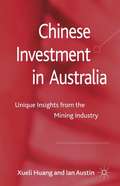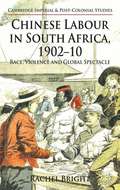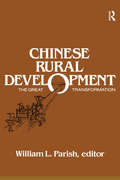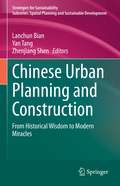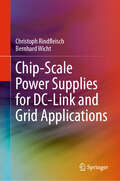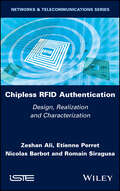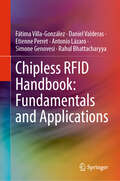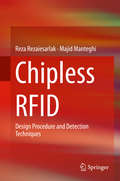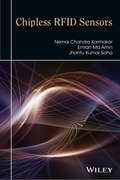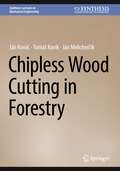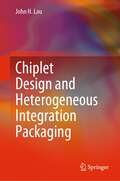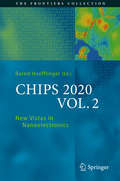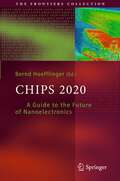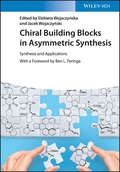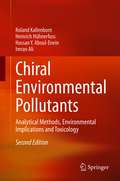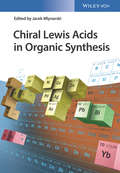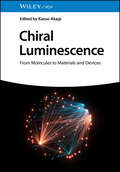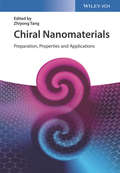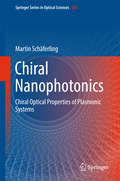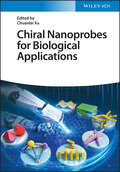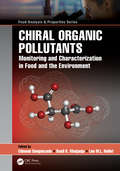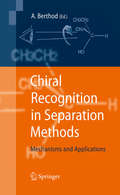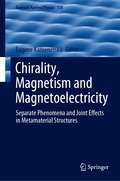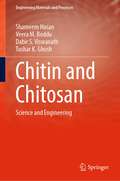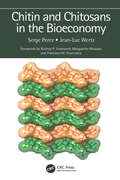- Table View
- List View
Chinese Investment in Australia
by Xueli Huang Ian AustinAustralia is renowned for its abundance of natural resources and is one of the largest recipients of Chinese direct investment. State- and privately-owned Chinese firms have invested heavily in the Australian minerals industry to secure a supply for their domestic production. In this book, the authors provide a comprehensive review of how Chinese firms have successfully invested in the Australian mineral industry based on their extensive research and consulting experiences. They provide unique insights into the entry processes used by Chinese investors, factors contributing to their successes, lessons they have learnt, and the challenges they have encountered in managing their investment. Moreover, the book also elaborates on how the political, economic and competitive forces in both countries influence Chinese investments in Australia. It is an informative tool for domestic and international policy makers, business professionals, academic and informed readers with interests on how China's resource requirements are impacting the Australian political and commercial landscape.
Chinese Labour in South Africa, 1902-10
by Rachel K. BrightThis book explores the decision of the British Empire to import Chinese labour to southern Africa despite the already tense racial situation in the region. It enables a clearer understanding of racial and political developments in southern Africa during the reconstruction period and places localised issues within a wider historiography.
Chinese Rural Development: The Great Transformation
by William L. ParishThis text examines the Pacific War, the Korean War and the Vietnam War, from the perspective of those who fought the wars and lived through them. The relationship between history and memory informs the book, and each war is relocated in the historical and cultural experiences of Asian countries.
Chinese Urban Planning and Construction: From Historical Wisdom to Modern Miracles (Strategies for Sustainability)
by Zhenjiang Shen Lanchun Bian Yan TangThis volume introduces and discusses the achievements and mechanisms of urban planning and construction in China from multiple professional perspectives, covering practices and processes ranging from ancient times to the present day. The book has 14 chapters, each addressing a specific Chinese urban planning and construction topic with examples and applications in various cities and regions, and each providing an all-around analysis of Chinese urban development issues at different scales, including government administrations, planning progresses, urban investments, social impacts and construction models. The book provides a comprehensive overview of urban planning and construction in China, especially its successful experiences in the historical period and modern era, which will greatly benefit scholars and readers who are interested in China, as well as urban planners, architects and historians. The book is organized into 4 main parts. Part 1 focuses on "historical wisdom" to summarize ancient Chinese efforts to cope with nature and the environment. It interprets the unique wisdom of ancient Chinese cities related to regional design, water conservancy system, and urban districts. Part 2 presents the “transformation" of urban planning in China by learning from both the traditional value and western experiences based on several cases, such as the spatial development of Beijing and the Beijing-Tianjin-Hebei capital region, the preservation of Qingdao city, the urban community development and regeneration in Chongqing city. Part 3 explores the "green and eco-city" by looking towards the future, illustrating Chinese practices and efforts to build more sustainable cities, such as green and low-carbon city construction in Wuhan, healthy city planning and eco-cities construction in China. Part 4 prospects the “modern miracles” brought forth by technological innovation and economic growth, and introduces the newest planning trends in China, such as the E-commerce Taobao villages in China and the innovation districts in Beijing. It also explains the driving force of the "growth machine" of Suzhou city.
Chip-Scale Power Supplies for DC-Link and Grid Applications
by Bernhard Wicht Christoph RindfleischThis book is a comprehensive single-source on the design of chip-scale high-voltage power supplies for low-power DC-link and grid applications. It is written in handbook style with systematic guidelines and includes implementation examples. The authors cover the full range, from technology fundamentals to circuit implementation details. The book includes guidelines for the application-specific selection of the converter topology, design guidelines for the inductive components, and a detailed description of low-power optimized control approaches and subcircuits. The authors also include guidelines for the selection and design of high-voltage on-chip power switches and for the reduction of parasitic effects such as capacitive losses.
Chipless RFID Authentication: Design, Realization and Characterization
by Etienne Perret Zeshan Ali Nicolas Barbot Romain SiragusaChipless RFID Authentication examines the development of highly secure product authentication systems for manufactured products by using chipless radio frequency identification (RFID) technology.The absence of a chip and its compatibility with mass production make chipless RFID an alternative to barcodes. This book discusses how, by using natural randomness inherent to the fabrication process, each chipless RFID tag has a unique signature that can never be reproduced, even if someone tries to copy the label.The book first explores the state-of-the-art of existing authentication and anti-counterfeiting methods based on their security level. Next, a methodology describing the characterization of chipless RFID tags for the authentication application is presented, followed by a discussion of the extraction of aspect-independent parameters for chipless RFID tags. After proposing designs for the tags, the book presents the realization and characterization of the labels (which exhibit naturally occurring randomness) for authentication, using printed circuit boards and inkjet printing on polyethylene terephthalate.
Chipless RFID Handbook: Fundamentals and Applications
by Etienne Perret Antonio Lázaro Fátima Villa-González Daniel Valderas Simone Genovesi Rahul BhattacharyyaChipless radio frequency identification (RFID) technology has emerged as a cost-effective alternative to conventional automated identification systems like RFID, QR codes, and barcodes. Simultaneously, it enables a wide array of novel applications, including recycling, structural health monitoring, and food safety, among many others. In this handbook, the authors provide an in-depth exploration of the design, manufacturing, and implementation guidelines of chipless RFID systems, including information encoding in chipless tags, the design of radar-based ultra-wideband (UWB) readers and antennas, as well as dedicated signal processing in time- and frequency-domain. This book is not only a practical resource for understanding the core principles and capabilities of chipless RFID, but also a rich source of expert knowledge for those wishing to deepen their understanding or explore particular applications. With real-world examples and detailed guidelines, the Chipless RFID Handbook serves as both a beginner-friendly introduction and an advanced reference on this emerging technology.
Chipless RFID: Design Procedure and Detection Techniques
by Reza Rezaiesarlak Majid ManteghiThis book examines the design of chipless RFID systems. The authors begin with the philosophy of RFID and its effect on commercial applications. Then, they discuss the chipless RFID systems and the application of chipless RFID systems, the advantages it provides compared to conventional barcode ID and chipped RFID tags. The text then covers chipless RFID components in block diagram representation and introduce FCC requirements which should be considered in the design procedure of each component. The third chapter is dedicated to the complex natural resonance-based design of chipless RFID tags. The next chapter concerns about the detection techniques introduced for the identification of chipless RFID tags. The fifth chapter is dedicated to the localization and anti-collision techniques in chipless RFID systems. Final chapter is chipless RFID tags as sensors. It provides some applications where the tag can be used as both ID and sensor. The tag specifications and detection issues are addressed in this section.
Chipless Rfid Sensors
by Nemai Chandra Karmakar Emran Amin Jhantu Kumar SahaA systematic treatment of the design and fabrication of chipless RFID sensors This book presents various sensing techniques incorporated into chipless RFID systems. The book is divided into five main sections: Introduction to Chipless RFID Sensors; RFID Sensor Design; Smart Materials; Fabrication, Integration and Testing; and Applications of Chipless RFID Sensors. After a comprehensive review of conventional RFID sensors, the book presents various passive microwave circuit designs to achieve compact, high data density and highly sensitive tag sensors for a number of real-world ubiquitous sensing applications. The book reviews the application of smart materials for microwave sensing and provides an overview of various micro- and nano-fabrication techniques with the potential to be used in the development of chipless RFID sensors. The authors also explore a chipless RFID reader design capable of reading data ID and sensory information from the chipless RFID sensors presented in the book. The unique features of the book are: Evaluating new chipless RFID sensor design that allow non-invasive PD detection and localization, real-time environment monitoring, and temperature threshold detection and humidity Providing a classification of smart materials based on sensing physical parameters (i. e. humidity, temperature, pH, gas, strain, light, etc. ) Discussing innovative micro- and nano-fabrication processes including printing suitable for chipless RFID sensors Presenting a detailed case study on various real-world applications including retail, pharmaceutical, logistics, power, and construction industries Chipless RFID Sensors is primarily written for researchers in the field of RF sensors but can serve as supplementary reading for graduate students and professors in electrical engineering and wireless communications.
Chipless Wood Cutting in Forestry (Synthesis Lectures on Mechanical Engineering)
by Ján Kováč Tomáš Kuvik Ján MelicherčíkThis scientific monograph presents the results obtained during research in the field of chipless logging and consists of two parts. At the beginning of the book, the current state of the researched task in chipless logging using chipless logging heads is presented. The experimental measurement methodology will be determined after reviewing the theoretical analysis of the cutting heads. The measurement methodology describes the principle of research carried out on an experimental hydraulic stand based on defined parameters. Data obtained during experimental measurement can be analyzed in many areas, e.g. statistical influence of individual factors as well as their combinations. The energy demand of chipless knives is also determined during experimental measurement.
Chiplet Design and Heterogeneous Integration Packaging
by John H. LauThe book focuses on the design, materials, process, fabrication, and reliability of chiplet design and heterogeneous integraton packaging. Both principles and engineering practice have been addressed, with more weight placed on engineering practice. This is achieved by providing in-depth study on a number of major topics such as chip partitioning, chip splitting, multiple system and heterogeneous integration with TSV-interposers, multiple system and heterogeneous integration with TSV-less interposers, chiplets lateral communication, system-in-package, fan-out wafer/panel-level packaging, and various Cu-Cu hybrid bonding. The book can benefit researchers, engineers, and graduate students in fields of electrical engineering, mechanical engineering, materials sciences, and industry engineering, etc.
Chips 2020 Vol. 2: New Vistas in Nanoelectronics (The Frontiers Collection)
by Bernd HoefflingerThe release of this second volume of CHIPS 2020 coincides with the 50th anniversary of Moore's Law, a critical year marked by the end of the nanometer roadmap and by a significantly reduced annual rise in chip performance. At the same time, we are witnessing a data explosion in the Internet, which is consuming 40% more electrical power every year, leading to fears of a major blackout of the Internet by 2020. The messages of the first CHIPS 2020, published in 2012, concerned the realization of quantum steps for improving the energy efficiency of all chip functions. With this second volume, we review these messages and amplify upon the most promising directions: ultra-low-voltage electronics, nanoscale monolithic 3D integration, relevant-data, brain- and human-vision-inspired processing, and energy harvesting for chip autonomy. The team of authors, enlarged by more world leaders in low-power, monolithic 3D, video, and Silicon brains, presents new vistas in nanoelectronics, promising Moore-like exponential growth sustainable through to the 2030s.
Chips 2020: A Guide to the Future of Nanoelectronics (The Frontiers Collection)
by Bernd HoefflingerThe chips in present-day cell phones already contain billions of sub-100-nanometer transistors. By 2020, however, we will see systems-on-chips with trillions of 10-nanometer transistors. But this will be the end of the miniaturization, because yet smaller transistors, containing just a few control atoms, are subject to statistical fluctuations and thus no longer useful. We also need to worry about a potential energy crisis, because in less than five years from now, with current chip technology, the internet alone would consume the total global electrical power! This book presents a new, sustainable roadmap towards ultra-low-energy (femto-Joule), high-performance electronics. The focus is on the energy-efficiency of the various chip functions: sensing, processing, and communication, in a top-down spirit involving new architectures such as silicon brains, ultra-low-voltage circuits, energy harvesting, and 3D silicon technologies. Recognized world leaders from industry and from the research community share their views of this nanoelectronics future. They discuss, among other things, ubiquitous communication based on mobile companions, health and care supported by autonomous implants and by personal carebots, safe and efficient mobility assisted by co-pilots equipped with intelligent micro-electromechanical systems, and internet-based education for a billion people from kindergarden to retirement. This book should help and interest all those who will have to make decisions associated with future electronics: students, graduates, educators, and researchers, as well as managers, investors, and policy makers. Introduction: Towards Sustainable 2020 Nanoelectronics.- From Microelectronics to Nanoelectronics.- The Future of Eight Chip Technologies.- Analog-Digital Interfaces.- Interconnects and Transceivers.- Requirements and Markets for Nanoelectronics.- ITRS: The International Technology Roadmap for Semiconductors.- Nanolithography.- Power-Efficient Design Challenges.- Superprocessors and Supercomputers.- Towards Terabit Memories.- 3D Integration for Wireless Multimedia.- The Next-Generation Mobile User-Experience.- MEMS (Micro-Electro-Mechanical Systems) for Automotive and Consumer.- Vision Sensors and Cameras.- Digital Neural Networks for New Media.- Retinal Implants for Blind Patients.- Silicon Brains.- Energy Harvesting and Chip Autonomy.- The Energy Crisis.- The Extreme-Technology Industry.- Education and Research for the Age of Nanoelectronics.- 2020 World with Chips.
Chiral Building Blocks in Asymmetric Synthesis: Synthesis and Applications
by Elżbieta Wojaczyńska Jacek WojaczyńskiChiral Building Blocks in Asymmetric Synthesis A comprehensive introduction to the important classes of chiral building blocks Chirality — the asymmetric quality found in certain chemical compounds — plays an essential role in our world: chiral compounds can be found in biology, pharmaceutical compounds, agrochemicals, and fragrances. The stereoselective preparation of these complex molecular constructions constitutes a challenge. To this end, modern asymmetric synthesis utilizes a variety of valuable and efficient reagents employed as chiral auxiliaries, metal complexes and organocatalysts in stereoselective catalysis, and enantiopure reactants termed as chiral building blocks. In Chiral Building Blocks in Asymmetric Synthesis, the achievements in the fields of preparation of and applications of chiral blocks are presented. In doing so, the book comprehensively discusses the important classes of these reactants as the key for the asymmetric synthesis of chiral molecules. As such, it is an indispensable resource about synthetic methods, as well as possible modifications and transformations of important classes of chiral compounds. It also highlights the importance of their use as reactants and auxiliaries in the preparation of more sophisticated molecules or supramolecular systems. In Chiral Building Blocks in Asymmetric Synthesis readers will also find: Organization according to the most important compound classes — e.g. amino acids, BINOL and its derivatives, terpenes, and others — with an emphasis on synthesis and application A focus on the use of chiral building blocks for the preparation of bioactive compounds and supramolecular assemblies Chiral Building Blocks in Asymmetric Synthesis is a useful reference for organic chemists, catalytic chemists, chemists in industry, medicinal chemists, pharmaceutical chemists, and the libraries that support them.
Chiral Environmental Pollutants: Analytical Methods, Environmental Implications and Toxicology
by Roland Kallenborn Imran Ali Hassan Y. Aboul-Enein Heinrich HühnerfussThis monograph contains a survey on the role of chirality in ecotoxicological processes. The focus is on environmental trace analysis. Areas such as toxicology, ecotoxicology, synthetic chemistry, biology, and physics are also covered in detail in order to explain the different properties of enantiomers in environmental samples. This monograph delivers a comprehensive survey for environmental trace analysts, analytical chemists, ecotoxicologists, food scientists and experienced lab workers.
Chiral Lewis Acids in Organic Synthesis
by Jacek MlynarskiA complete overview covering the application of metal-based chiral Lewis acids from all parts of the periodic table, the Author emphasizes the most recent contributions to the field as well as prominent direction of development. The book discusses the design of chiral complexes as well as a wide spectrum of reactions promoted by various chiral Lewis acids, including water-compatible acids as well as the most important applications in the chemical and pharmaceutical industries. A must-have for catalytic and organic chemists working in the field, both in academia and industry, as well as pharmaceutical and medicinal chemists.
Chiral Luminescence: From Molecules to Materials and Devices
by Kazuo AkagiComprehensive resource illustrating the latest stage and development of chiral luminescence in science and technology, from fundamentals to applications Chiral Luminescence imparts a comprehensive understanding for chiral materials bearing circularly polarized luminescence (CPL) functions, including molecules, oligomers, polymers, chiral metal organic complexes, and chiral biochemical materials, with guidance on how to promote and control this kind of luminescence towards the development of advanced photonic materials and devices such as chiroptical and electronic devices, next-generation displays, and others. The book covers detailed information on the molecular design, synthesis, and polymerization methods of chiral luminescent materials, the evaluation of chiroptical properties represented by CPL, novel spectroscopic instruments and techniques, the fabrication of chiral luminescent devices such CPL-OLED, a theoretical evaluation, and potential applications. With insight from leading academics and industrial researchers in the field, Chiral Luminescence includes information on: Optical resolution and chiroptical properties of partially overlapping carbazolophanes and developments in CPL research using cyclodextrins Synthesis and chiroptical properties of helical, conjugated polymers and twisted molecules, and chiroptical and magnetooptical properties of porphyrin compounds Principles of CPL measurement systems and advances in measurement methods, and intense and sign-invertible CPL Development of organic light-emitting diodes using aggregation-induced enhanced CPL perylene diimides Binding constants as fundamental physical properties for quantitative treatments of sensing processes in supramolecular systems Providing far-reaching coverage of chiral luminescence and its many applications, Chiral Luminescence is a must-read resource for a variety of chemists and engineers who wish to understand the state-of-the-art development in this optical science.
Chiral Nanomaterials: Preparation, Properties and Applications
by Zhiyong TangThorough and up-to-date, this book presents recent developments in this exciting research field. To begin with, the text covers the fabrication of chiral nanomaterials via various synthesis methods, including electron beam lithography, ion beam etching, chemical synthesis and biological DNA directed assembly. This is followed by the relevant theory and reaction mechanisms, with a discussion of the characterization of chiral nanomaterials according to the optical properties of metal nanoparticles, semiconductor nanocrystals, and nanoclusters. The whole is rounded off by a summary of applications in the field of catalysis, sensors, and biomedicine. With its comprehensive yet concise coverage of the whole spectrum of research, this is invaluable reading for senior researchers and entrants to the field of nanoscience and materials science.
Chiral Nanophotonics: Chiral Optical Properties of Plasmonic Systems (Springer Series in Optical Sciences #205)
by Martin SchäferlingThis book describes the physics behind the optical properties of plasmonic nanostructures focusing on chiral aspects. It explains in detail how the geometry determines chiral near-fields and how to tailor their shape and strength. Electromagnetic fields with strong optical chirality interact strongly with chiral molecules and, therefore, can be used for enhancing the sensitivity of chiroptical spectroscopy techniques. Besides a short review of the latest results in the field of plasmonically enhanced enantiomer discrimination, this book introduces the concept of chiral plasmonic near-field sources for enhanced chiroptical spectroscopy. The discussion of the fundamental properties of these light sources provides the theoretical basis for further optimizations and is of interest for researchers at the intersection of nano-optics, plasmonics and stereochemistry.
Chiral Nanoprobes for Biological Applications
by Chuanlai XuA comprehensive overview exploring the biological applications of chiral nanomaterials Chirality has been the centerpiece of many multidisciplinary fields within the broader umbrella of the sciences. Recent advancements in nanoscience have spurred a growing interest in the dynamic field of chiral nanomaterials. In particular, the recent breakthroughs in chiral nanocrystals have presented an intriguing avenue whose potential application may address some key issues at the heart of nanosciences. While little attention has been focused on the biological implications of such advances, this arena is attracting theoretical and applicative interests. Seeking to provide a thorough introduction to the field as well as fill this gap in scholarship, Chiral Nanoprobes for Biological Applications first provides a comprehensive review of the state-of-the-art development of strong chiroptical nanomaterials, describing how a synthesis and self-assembly approach can enable one to design and create a number of functional chiral nanomaterials. From there, the authors discuss the biological applications of chiral nanomaterials, such as extracellular bioanalysis, intracellular bioanalysis, and chiral recognition, as well as photothermal and photodynamics therapy. In doing so, the book seeks emphasize the potential in multidisciplinary approaches to this up-and-coming field. Chiral Nanoprobes for Biological Applications readers will also find: A particular emphasis on milestones achieved for key chiral nanoprobes research from the last five years A discussion of future research directions A helpful guide for new researchers and established professionals alike Chiral Nanoprobes for Biological Applications is a useful reference for materials scientists, biochemists, protein chemists, stereo chemists, polymer chemists, and physical chemists. It is also a useful tool for libraries.
Chiral Organic Pollutants: Monitoring and Characterization in Food and the Environment (Food Analysis & Properties)
by Leo M.L. Nollet Basil K. Munjanja Edmond SanganyadoChiral Organic Pollutants introduces readers to the growing challenges of chirality in synthetic chemicals. In this volume, contributors brilliantly summarize the characteristics of chiral pollutants to provide tools and techniques for effectively assessing their environmental and human health risks. Chapters cover recent research on the physicochemical properties, sources, exposure pathways, environmental fate, toxicity, and enantioselective analysis of chiral organic pollutants. Chiral Organic Pollutants also provides comprehensive discussions on the current trends in the synthesis and legislation of chiral chemicals. Key Features: Includes sampling and analytical methods for the enantioselective analysis of a wide array of chiral organic pollutants in food and the environment Summarizes recent research on the sources, fate, transport, and toxicity of chiral organic pollutants in the environment Critically examines the sources and pathways of chiral organic pollutants such as pesticides, pharmaceuticals, and flame retardants in food Includes a comprehensive discussion on current trends in the enantioselective synthesis and chiral switching of pesticides and pharmaceuticals Provides analysis of current national and international regulations of chiral synthetic chemicals The use of chiral synthetic chemicals such as pesticides, pharmaceuticals, personal care products, and halogenated flame retardants has significantly grown in the past 60 years. Hence, understanding the human and environmental health effects of chiral organic pollutants is crucial in the industry, academia, and policymaking. Chiral Organic Pollutants is an excellent textbook and reference for students, scientists, engineers, and policymakers interested in food quality, environmental pollution, chemical analysis, organic synthesis, and toxicology. Also available in the Food Analysis and Properties Series: Analysis of Nanoplastics and Microplastics in Food, edited by Leo. M.L. Nollet and Khwaja Salahuddin Siddiqi (ISBN: 9781138600188) Proteomics for Food Authentication, edited by Leo M.L. Nollet, and Semih Ötleş (ISBN: 9780367205058) Mass Spectrometry Imaging in Food Analysis, edited by Leo M.L. Nollet (ISBN: 9781138370692) For a complete list of books in this series, please visit our website at: www.crcpress.com/Food-Analysis--Properties/book-series/CRCFOODANPRO
Chiral Recognition in Separation Methods: Mechanisms and Applications
by Alain BerthodThe importance of chiral interactions for both preparative and analytical separations, particularly for pharmaceutical applications, is underlined by numerous publications in this field. Here, for the first time, a team of experienced analysts from industry and academe presents a comprehensive review of the various mechanisms that result in enantiomer separations. A better understanding of these processes is crucial for setting as well as improving chiral separation procedures and also for developing new applications. The coverage in this book includes a range of separation methods, such as gas, liquid, or countercurrent chromatography, and capillary electrophoresis. The special case of chiral ionic liquids is examined in detail. Most modern chiral selectors are discussed, including derivatized polysaccharide- and cyclodextrin-based selectors, along with a newly introduced class of carbohydrates: the cyclofructose selectors. This publication will be required reading not only for research and development departments in the pharmaceutical and cosmetic industries, but also for researchers in toxicology, environmental monitoring, and food research.
Chirality, Magnetism and Magnetoelectricity: Separate Phenomena and Joint Effects in Metamaterial Structures (Topics in Applied Physics #138)
by Eugene KamenetskiiThis book discusses theoretical and experimental advances in metamaterial structures, which are of fundamental importance to many applications in microwave and optical-wave physics and materials science. Metamaterial structures exhibit time-reversal and space-inversion symmetry breaking due to the effects of magnetism and chirality. The book addresses the characteristic properties of various symmetry breaking processes by studying field-matter interaction with use of conventional electromagnetic waves and novel types of engineered fields: twisted-photon fields, toroidal fields, and magnetoelectric fields. In a system with a combined effect of simultaneous breaking of space and time inversion symmetries, one observes the magnetochiral effect. Another similar phenomenon featuring space-time inversion symmetries is related to use of magnetoelectric materials. Cross-coupling of the electric and magnetic components in these material structures, leading to the appearance of new magnetic modes with an electric excitation channel – electromagnons and skyrmions – has resulted in a wealth of strong optical effects such as directional dichroism, magnetochiral dichroism, and rotatory power of the fields. This book contains multifaceted contributions from international leading experts and covers the essential aspects of symmetry-breaking effects, including theory, modeling and design, proven and potential applications in practical devices, fabrication, characterization and measurement. It is ideally suited as an introduction and basic reference work for researchers and graduate students entering this field.
Chitin and Chitosan: Science and Engineering (Engineering Materials and Processes)
by Tushar K. Ghosh Veera M. Boddu Dabir S. Viswanath Shameem HasanThis book reviews work that covers everything from basic chemistry to advanced applications. Chitin and chitosan are used in a plethora of applications from wastewater treatment to prosthetics. After introducing the subject of polysaccharides as a whole, the authors turn to the preparation of chitin and chitosan and the characterization of the latter. The book provides information on chitin chemistry, extraction of chitin, chitosan preparation processes, and the applications of their derivatives in various fields. Among the applications that are included in detail are the adsorption of heavy metals for pollution prevention and clean-up, biosensors, cosmetics, various medical applications from anti-tumor activity to bone tissue engineering, agriculture and food production, and proton exchange membranes for fuel cells.Chitin and Chitosan features:• information on molecular structure, synthesis, properties, and latest research related to chitin and chitosan;• coverage of a wide range of topics from the properties of chitosan to its derivatives and applications;• in-depth information on biomedical applications of chitin and chitosan; and• information that can be applied to other biopolymer processing engineering areas.This book will be of interest to practitioners working in a wide variety of industries for which chitin and chitosan are useful materials, researchers in biosensors and heavy-metal adsorption, and to academic researchers investigating the properties, preparation, and uses of these materials.
Chitin and Chitosans in the Bioeconomy
by Jean-Luc Wertz Serge PerezChitin is the second most abundant natural polymer in the world after cellulose, mainly derived from the food waste of shrimp and crabs. Chitosan is the most important derivative of chitin. Thanks to their biodegradability, non-toxicity, biocompatibility, bioactivity, and versatile chemical and physical properties, chitin and chitosan derivatives are used in a wide variety of applications, including water treatment, cosmetics and toiletries, food and beverages, healthcare/medical, and agrochemicals. Chitin and Chitosans in the Bioeconomy covers all major aspects of chitin and chitosan, including structure, biosynthesis, biodegradation, properties of chitin and derivatives, applications, and market. It offers a special focus on the bioeconomy, which is the renewable segment of the circular economy. Describes the structure, biosynthesis, and biodegradation of chitin and chitosan Covers chitin- and chitosan-based products Details valorization of these materials Presents information on shell biorefineries Chitin and Chitosans in the Bioeconomy serves as a reference for polymer scientists and engineers and is also accessible to economists and advanced students.
